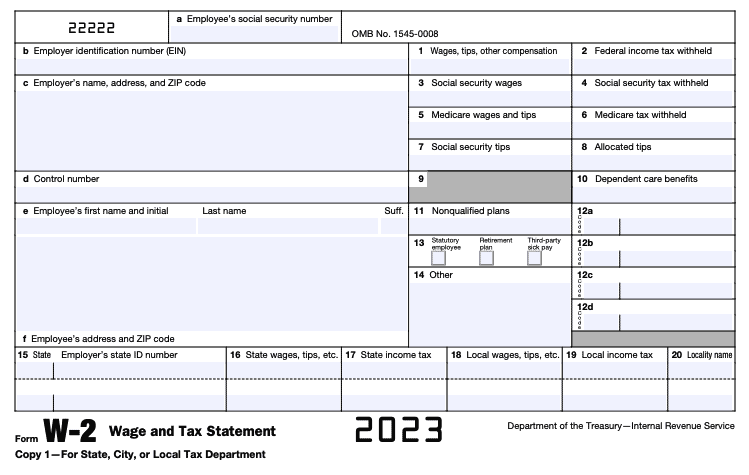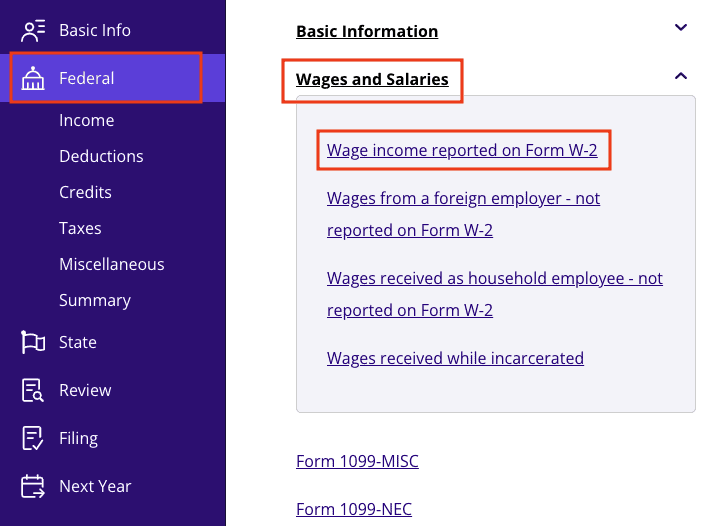Have you ever wondered how to make sense of Form W-2? A W-2 form is more than just a piece of paper; it’s a breakdown of your income, taxes, and other important details that your employer must provide to you and the IRS. This guide will explain everything you need to know about Form W-2, including its significance, what each component means, and how it can affect your taxes and potential refunds. Let’s break it down.
At a glance:
- Form W-2 tells you how much tax your employer withheld from your paycheck.
- Your employer sends copies of your W-2 form to the IRS, so it’s important to report your income correctly.
What is a W-2 form?
The W-2 form is the tax form that an employer must send to their employees and the Internal Revenue Service (IRS) at the end of each year. Officially called your Wage and Tax Statement, your W-2 form reports your annual wages as an employee and the amount of taxes withheld from your paycheck.
If you work for an employer, your employer withholds income taxes from each of your paychecks. That’s because both federal and most state governments collect income tax year-round, not just on April 15, 2024 (the tax filing deadline for tax year 2023). The W-2 form wage statement lists exactly how much money you made the previous year, how much went to tax withholdings, and how much of it went to federal taxes and state taxes.
Form W-2 example
Form W-2 proves very useful when you file your Form 1040 income tax return. It contains your gross wages, tips, and other compensation for the year, and it also tells you how much money was withheld in federal and state income tax. Here’s what the form looks like:

Form W-2 instructions
How do I read my W-2?
Let’s take a detailed look at what each box of Form W-2 means.
Starting with the boxes on the left:
- Box a: Reports your Social Security number (SSN). Ensure this is correct — an incorrect SSN can delay the processing of your tax return.
- Box b: Your employer’s Employer Identification Number (EIN) is reported in box b. An EIN is a nine-digit number assigned to your employer by the IRS and used to identify the tax accounts of employers.
- Box c: Reports the legal address of your employer. This may or may not be the actual address of where you work, depending on if your employer has multiple offices with a corporate site.
- Box d: Reports the control number used by your employer’s payroll department. This may or may not be blank.
- Box e and f: Your legal name, as it reads on your Social Security card, appears in box e, and your mailing address is reported in box f. Double-check both are correct. If that information is incorrect, it could delay the processing of your return.
Here’s a closer look at the boxes on the right:
- Box 1: Shows your total taxable wages, tips, prizes, and other compensation for the year, minus certain elective deferrals, such as 401(k) plans, pretax benefits, and payroll deductions. The number from box 1, your income, is reported on line 7 of your Form 1040.
- Box 2: Reports the total federal income tax withheld from your pay during the year. This amount is based on the information you included on your Form W-4 with your employer. If you’d rather keep more money in your paycheck each week, you’ll want to adjust your Form W-4 for the next year. Federal taxes withheld in box 2 are reported on line 62 of your Form 1040.
- Box 3: Shows your total wages that are taxed for Social Security.
- Box 4: Shows the total Social Security taxes withheld from your pay for the year. Unlike federal income taxes, Social Security taxes are calculated based on a flat rate of 6.2% for employees.
- Box 5: Indicates all your wages and tips that are taxed for Medicare.
- Box 6: The total amount of Medicare tax withheld from your pay for the year. Much like Social Security taxes, Medicare taxes are also figured on a flat rate, which is 1.45% for employees.
- Box 7: Shows any tips that you reported.
- Box 8: Shows any allocated tips that your employer has figured attributable to you. These are considered as income.
- Box 9: Should be blank, as this requirement has expired.
- Box 10: Reports the total amount deducted from your wages for dependent care assistance programs. It may also include contributions made by your employer for dependent care on your behalf.
- Box 11: Reports the total amount distributed to you from your employer’s non-qualified deferred compensation plan.
- Box 12: Reports several different types of compensation and benefits. If applicable, this box will indicate a single or double letter code followed by a dollar amount.
- Box 13: Your employer checks the applicable box that pertains to you as an employee.
- Statutory employee means employees whose earnings are subject to Social Security and Medicare taxes but not federal income tax withholding.
- Retirement plan means you participated in your employer’s retirement plan during the year.
- Third-party sick pay means you received sick pay under your employer’s third-party insurance policy.
- Box 14: Reports anything that doesn’t have a specific box anywhere else on Form W-2.
- Box 15: Includes your employer’s state and state tax identification number.
- Box 16: Indicates the total amount of taxable wages for state tax purposes (if you are subject to state income taxes).
- Box 17: Shows the total amount of state taxes withheld from your wages for the year.
- Box 18: If you are subject to local, city, or other state income taxes, box 18 reports those wages.
- Box 19: Reports the total amount withheld from your wages for local, city, or other state income taxes.
- Box 20: Is the legal name of the local, city, or other state tax being reported in box 19.
Form W-2 FAQs
When do I receive my W-2?
The deadline for employers to send out W-2 forms is Jan. 31, meaning you should receive a Form W-2 Wage and Tax Statement from your employer in January or early February every tax filing season.
Who gets a copy of Form W-2?
You’re not the only one who receives a copy of your W-2 form. Your employer must send copies of your Form W-2 to:
- The federal government
- Your state government (and your city and local governments)
The IRS calls Form W-2 an informational return because it informs the above parties about your earnings and the amount of taxes you paid for the year.
Who fills out Form W-2?
Form W-2 is one of those tax forms that you, the taxpayer, don’t have to fill out. Your employer provides all the information on the form and mails the document to all parties.
Note: You are required to attach your copy of Form W-2 to your tax return. If you e-file using TaxAct®, we send your Form W-2 information along with your tax return. However, if you are filing your tax return by mail, then you must include a copy with your return.
How does tax withholding from my W-2 affect my tax refund?
All the information on your Form W-2 helps determine whether you owe more taxes or whether you receive a tax refund when filing your taxes.
If you find that you regularly have a big tax bill in April, you may want to adjust your tax withholdings. This is done using Form W-4. If you have the opposite problem — a big tax refund each April — then you are withholding too much from each paycheck.
You probably filled out a Form W-4 on your first day at work — this form tells your employer how much tax to withhold from your paycheck. You can fill out a new W-4 form if you wish to make changes to your tax withholding. Consider using TaxAct’s W-4 Calculator (Refund Booster1) to see how changes to your withholding allowances could affect your tax refund and paycheck amounts.
Does every taxpayer receive a W-2 form?
No, only employees receive Form W-2. Freelancers and independent contractors receive Form 1099-NEC, another kind of informational return for non-employee compensation. This form reports all income earned by independent contractors or freelancers during the year. (Prior to 2020, nonemployee compensation was reported using Form 1099-MISC.)
Even if you aren’t self-employed, there are also other types of 1099 forms for other types of income, such as a 1099-K for payment cards and third-party network transactions, or a 1099-B for capital gains from selling stocks, or 1099-INT for any interest you received — all of which count as income and need to be reported on your income tax return.
What do I do if I never received my W-2 form?
It’s best to wait until mid-February to worry about your W-2 since it might just be late in the mail. But if you still haven’t gotten it by the end of February, it may be time to reach out to your employer. Here are some tips on what to do if you didn’t receive your W-2.
What do the letter codes mean in Box 12 of my W-2?
Box 12 on your W-2 form shows various types of compensation and benefits. If applicable, this box will indicate a single or double-letter code followed by a dollar amount. We have a helpful table of all W-2 Box 12 letter codes here.
When should I hire 1099 contractors vs. W-2 employees?
As a business owner, you should hire 1099 contractors when you need someone for short-term, project-based work or specialized tasks that don’t require close supervision. Contractors typically have more control over their schedules, work methods, and tools, and you won’t be responsible for providing benefits or withholding taxes.
On the other hand, W-2 employees are ideal when you need long-term, ongoing help where you can provide direction, set hours, and manage their workflow. Employees are typically entitled to benefits like health insurance, and you’ll need to withhold payroll taxes on their behalf.
For a more detailed comparison, check out our answers to FAQs on hiring 1099 contractors vs. W-2 employees.
How to file Form W-2 with TaxAct
Reporting your income from Form W-2 is easy when you e-file with TaxAct. Here’s how to enter your W-2 into our tax preparation software:
- From within your TaxAct return (Online or Desktop), click Federal. (On smaller devices, click in the top left corner of your screen, then click Federal).
- Click the Wages and Salaries dropdown, then click Wage income reported on Form W-2.

3. Click + Add Form W-2 to create a new copy of the form or click Edit to edit a form already created. (Desktop program: click Review instead of Edit).
4. Continue with the interview process to enter your information.
If it’s your first time through the Q&A, just follow the interview process. On the screen titled What kind of income did you have in 2023?, click the checkbox next to Worked as an employee (Form W-2).
The bottom line
Understanding your Form W-2 is a key part of accurate tax filing. While it may look complicated at first, breaking down each box helps make sense of your income, withholdings, and other crucial details. By knowing how to read and use this form, you can confidently file your taxes and even adjust your federal tax withholdings if needed to better manage your finances throughout the year.

